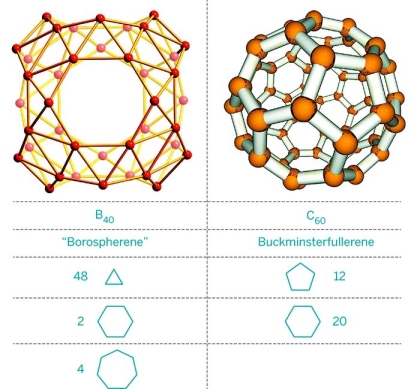博文
全硼富勒烯笼状结构:中美科学家合作的结晶
 精选
精选
||||
全硼富勒烯笼状结构:中美科学家合作的结晶
诸平
虽然2014年7月14日《光明日报》曾经发表过“中美学者携手发现全硼富勒烯团簇”的相关报道,但是 2014年7月21日,美国化学会C&EN周刊网站也对此进行了报道。
山西大学分子科学研究所翟华金(Hua-Jin Zhai)教授兴奋地向记者介绍说,山西大学、清华大学、美国布朗大学及复旦大学化学家密切合作,首次发现了全硼富勒烯B40团簇(All-Boron Fullerene),并将其命名为硼球烯(Borospherene)。该研究成果于2014年7月13日在国际权威学术期刊《自然·化学》(Nature Chemistry)在线发表——Hua-Jin Zhai, Ya-Fan Zhao, Wei-Li Li, Qiang Chen, Hui Bai, Han-Shi Hu, Zachary A. Piazza, Wen-Juan Tian, Hai-Gang Lu, Yan-Bo Wu, Yue-Wen Mu, Guang-Feng Wei, Zhi-Pan Liu, Jun Li, Si-Dian Li & Lai-Sheng Wang. Observation of an all-boron fullerene. Nature Chemistry, 2014, doi:10.1038/nchem.1999,Received 11 February 2014; Accepted 09 June 2014; Published online 13 July 2014.图1是B40团簇球烯化合物的结构,酷似中国逢年过节的红灯笼。这是在硼化学和类富勒烯研究研究领域取得的一项重大突破。

图1 全硼富勒烯B40团簇与中国红灯笼
B40的发现是硼球烯实验和理论研究的开端,是一个与碳富勒烯平行、具有广阔应用前景的科学研究新领域。研究表明,硼球烯和低维硼纳米结构与相应碳富勒烯和低维碳纳米材料在性能上具有很强的互补性,两者结合可能对解决人类面临的能源和环境危机提供新的科学思路和技术。
1985年,以笼状C60为代表的碳富勒烯家族的发现成为世界科学史上的重要里程碑。该成果1996年获诺贝尔化学奖,为之后的单壁碳纳米管及单原子层石墨烯的发现奠定了基础。翟华金教授说,B40是继C60之后第二个从实验和理论上完全确认的无机非金属笼状团簇,但由于硼的典型缺电子性,B40具有与传统碳富勒烯显著不同的结构和成键特征。它可以进一步作为分子器件,进行各种金属掺杂、化学修饰和配体保护,形成具有新颖结构的一维、二维和三维纳米材料,在储氢储锂、半导体、超导、绿色催化等领域具有重要应用前景。
据介绍,2013年3月以来,山西大学分子科学研究所翟华金教授、李思殿(Si-Dian Li)教授与清华大学李隽(Jun Li)教授、Ya-Fan Zhao和Han-Shi Hu,美国布朗大学(BrownUniversity)化学系的Lai-Sheng Wang教授、Wei-Li Li以及Zachary A. Piazza;复旦大学化学系的刘智攀(Zhi-Pan Liu)教授及Guang-Feng Wei合作,结合特征实验光电子能谱、全局结构搜索和严格量子化学理论计算,经过一年多的艰苦努力和协同创新,首次在气相中观察到由双链交织而成、具有完美D2d对称性的笼状B40全硼富勒烯团簇。该空心笼状分子由顶端和底端两个相互交错的B6六元环及腰上两两相对的四个B7七元环相互融合而成,沿二重主轴方向略有拉长,整体分子恰似传统的“中国红灯笼”(见图1)。
2014年7月21日,美国化学会C&EN周刊网站,以“硼键进入类富勒烯笼结构”(Boron Bonds IntoFullerene-Like Cage Structure)为题,报道了中美科学家合作研究的结晶——B40,称之为“首次发现全硼富勒烯显示不寻常的成键结构(First observed all-boron fullerene displays unusual bonding, structure)。美国北伊利诺斯大学(Northern Illinois University)的硼研究者Narayan S. Hosmane说,此研究报告不一定是令人惊讶的。因为他的导师,也是诺贝尔奖获得者William N. Lips曾经在20世纪70年代就预测了类巴基球硼烷(BxHy)结构。Hosmane认为硼球烯(borospherene)和硼杂原子富勒烯可能在医学和新奇的电子产品等领域是有用的。就目睹长达数十年的搜索顶点而言,B40的出现“这是令人兴奋的事情。”更多信息请浏览原文:

图2 B40和C60多面体结构的比较
Boron Bonds Into Fullerene-Like Cage Structure
The discovery of soccer-ball-shapedbuckminsterfullerene in 1985 inspired researchers to lock atoms of a single element together into novel shapes, such as nanotubes, for applications in drug delivery and electronics. But the search for one alluring nanostructure has vexed researchers for decades. A team is now reporting the first molecular cage made entirely of boron (Nat. Chem. 2014, DOI:10.1038/nchem.1999).
Unlike a C60 buckyball’s regular patchwork of pentagons and hexagons, the newly discovered boron molecule, B40–, looks a bit like a rounded box with two hexagonal lids, four heptagonal sides, and 48 triangles filling out its form. The boron-boron bonds in the “borospherene” are also exotic. Delocalized π- and σ-bonds hold the boron fullerene together, with electrons shared among three, five, six, or seven atoms. This unique bonding situation alone makes the discovery noteworthy, says computational chemistAnastassia N. Alexandrova of UCLA, who was not part of the study. But the work also appears to solve a long-standing problem: Boron analogs to carbon cages have long eluded chemical synthesis.
Since the advent of carbon fullerenes, scientists have been trying to make an analogous boron cage. They were hopeful because boron neighbors carbon on the periodic table and because nanoengineered boron might be a boon for a range of applications.
Researchers at Brown University and three universities in China have now identified and characterized borospherene by combining computational chemistry and spectroscopic techniques. Using supercomputers, the team screened more than 10,000 structures made of 40 boron atoms. Two energetically favorable types of candidates emerged: all-boron fullerenes and quasi-planar sheets. The scientists then calculated electron binding energies for both types of structures to produce simulated photoelectron spectra, or what team leader Lai-Sheng Wang of Brown calls “electronic fingerprints.”
The team blasted a boron target with a laser to produce a vapor of atoms that condensed into boron clusters as it was cooled by helium gas. A mass spectrometer selected out only boron clusters with 40 atoms to be sent to the photoelectron spectroscopy stage.
The team found that only a mixture of the spectra from simulated planar and fullerene structures could produce the experimental spectrum. A distinctive peak at low energies was key to the conclusion.
“That low binding energy feature can only be produced by a three-dimensional cage,” says Wang, who has studied all-boron molecules, from B3 to B36 since 2001. All of those clusters were two-dimensional or quasi-planar. “We’ve never observed a boron cluster with such a low binding energy.”
The researchers also predicted based on their calculations that uncharged B40 fullerenes were stable and thus could be formed. But without a charge, they cannot be sorted by mass spectrometry and measured experimentally at this time.
Narayan S. Hosmane, a boron researcher at Northern Illinois University, says the report isn’t necessarily surprising. His mentor, Nobel Laureate William N. Lips--comb Jr., predicted the structure of buckyball-like boranes (BxHy) in the 1970s. Hosmane believes borospherene and boron-based heteroatom fullerenes could be useful in medicine and novel electronics.
As for witnessing the culmination of a decades-long search, Hosmane says, “This is something exciting.”
https://m.sciencenet.cn/blog-212210-813788.html
上一篇:新《ACS传染病》杂志与其主编奥尔德里奇
下一篇:2014年第46届国际化学奥林匹克竞赛预备试题及答案